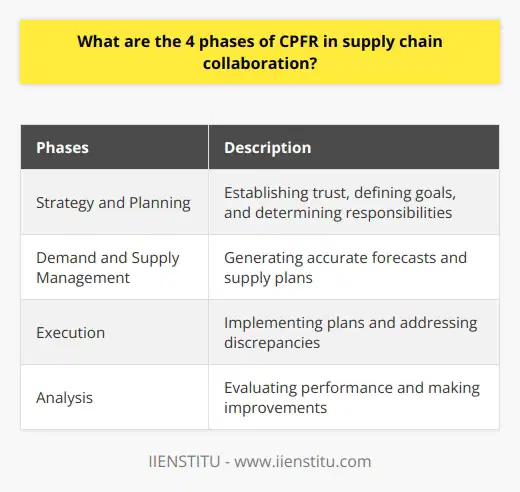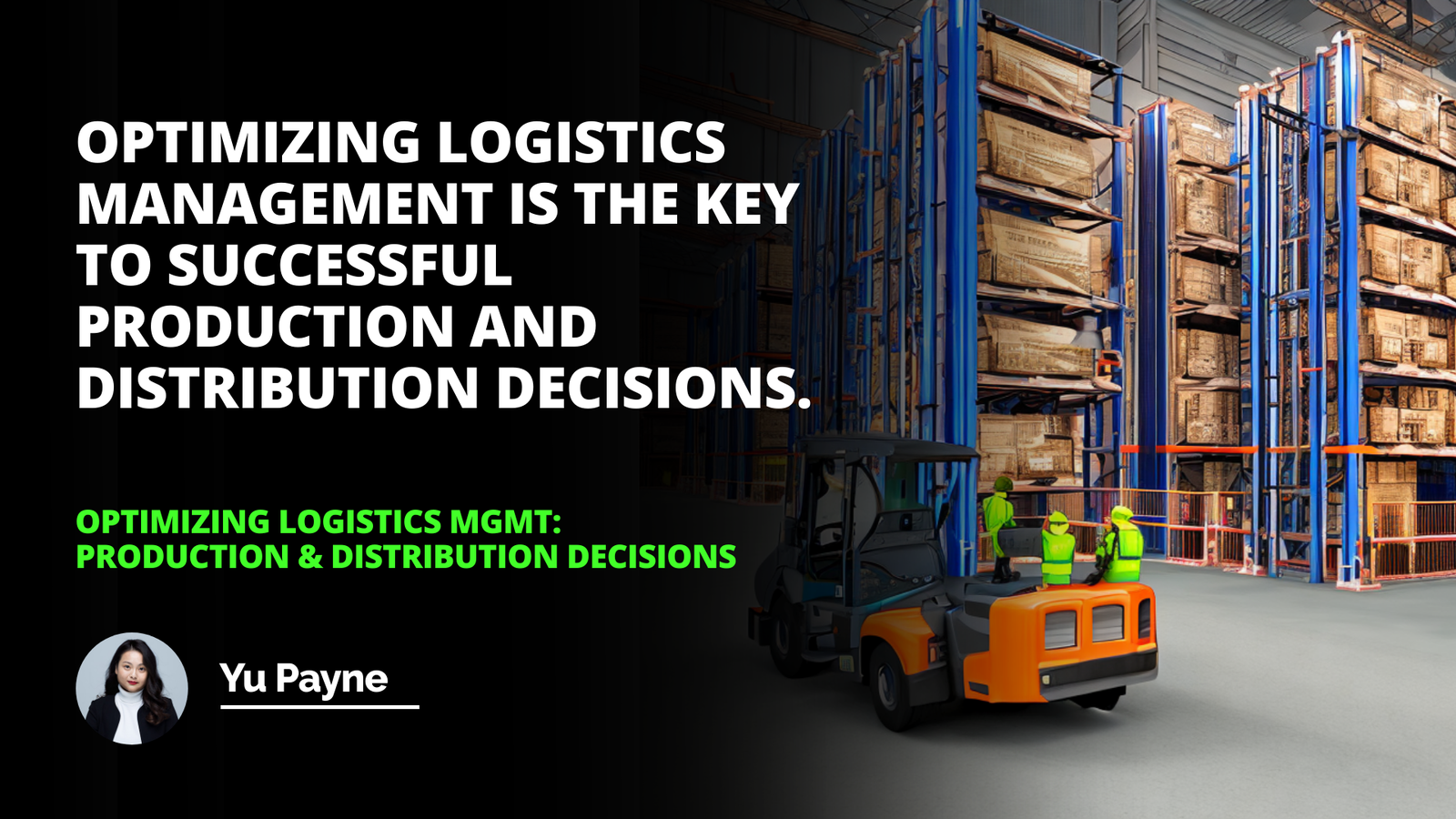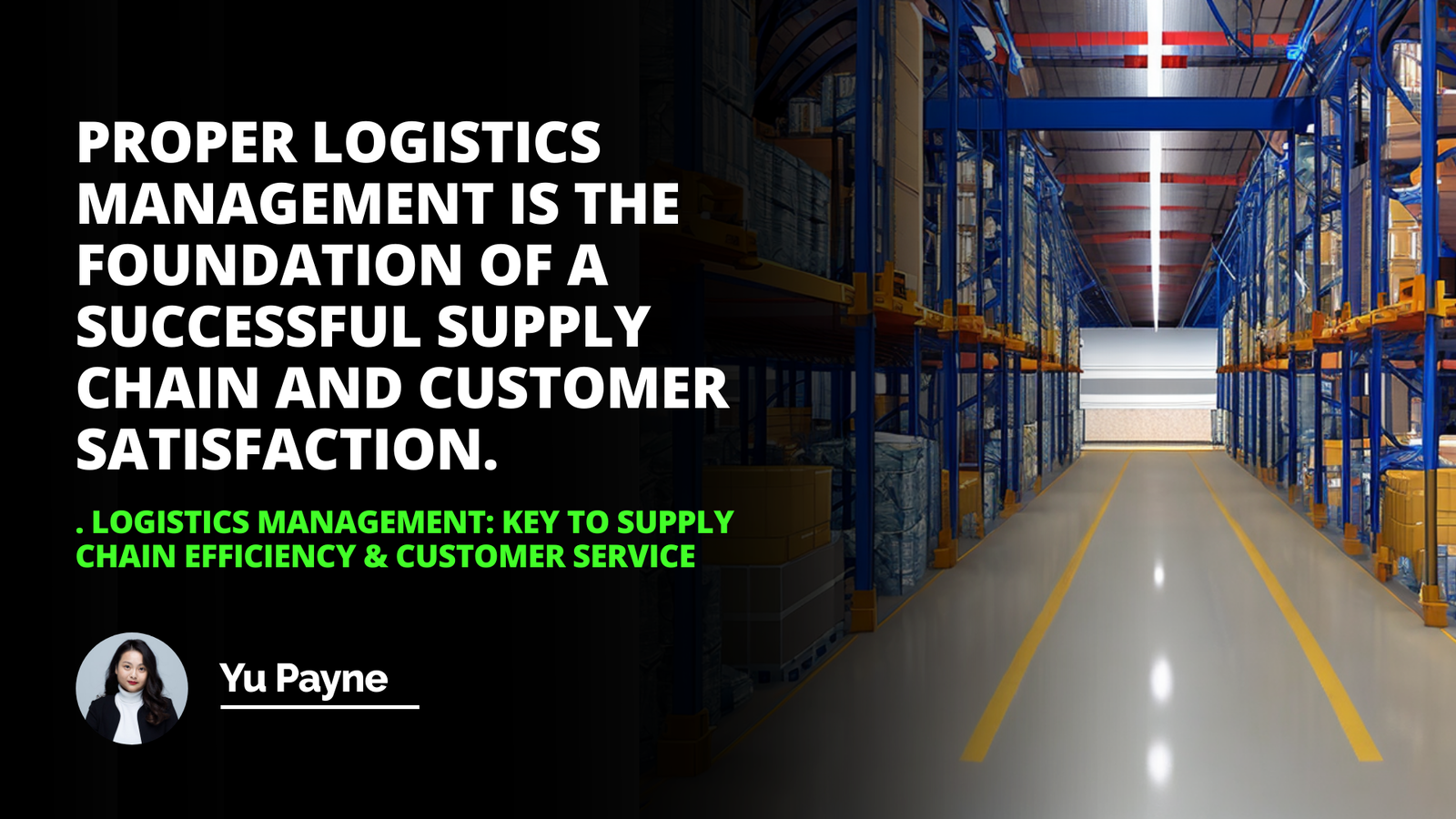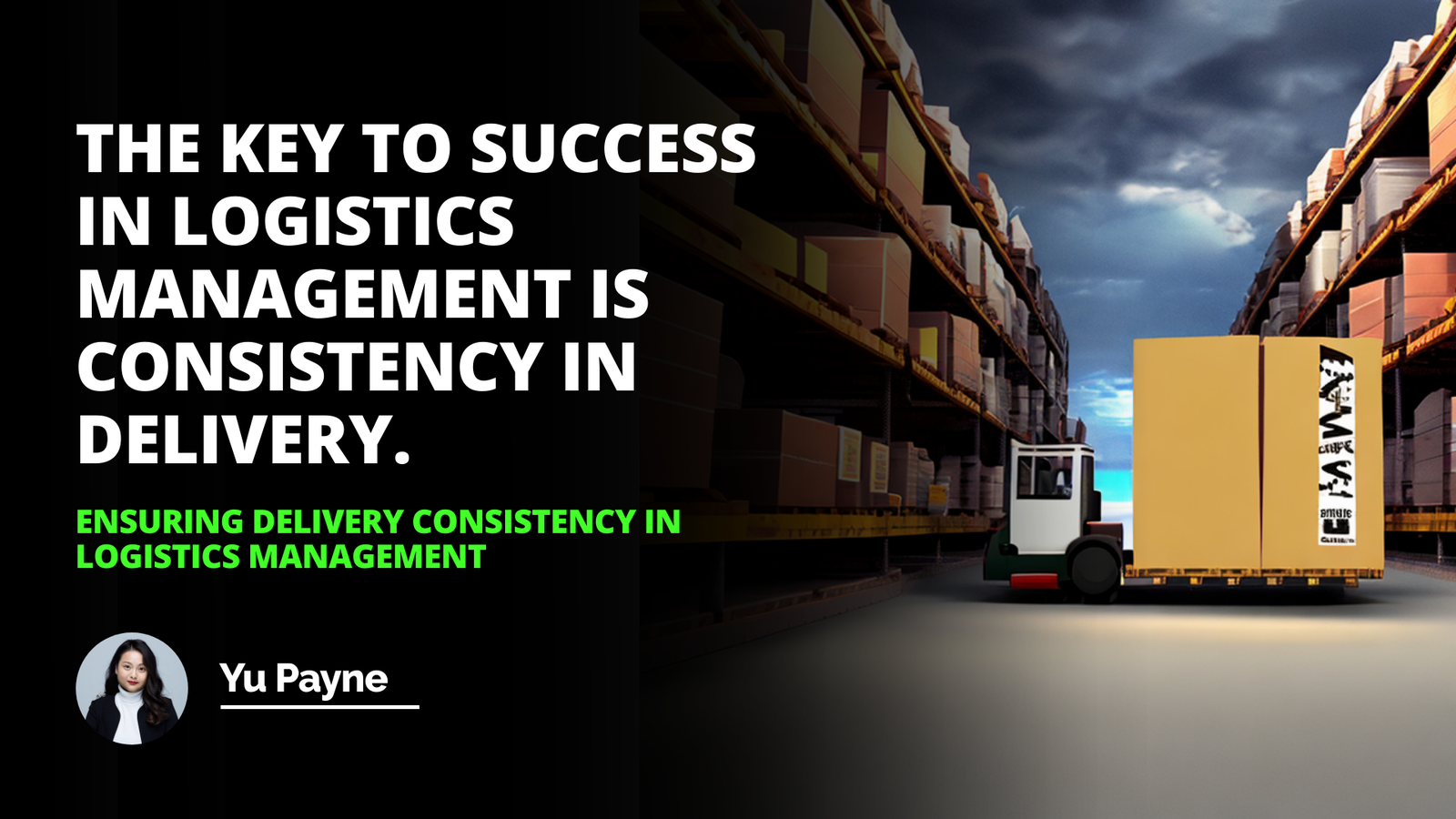
You know, I've always been fascinated by how things we use every day reach us exactly when we need them. It's like magic, but of course, it's not magic—it's the result of a carefully orchestrated dance known as supply chain management. A few years ago, while working with a mid-sized retailer, I stumbled upon the concept of Collaborative Planning, Forecasting, and Replenishment (CPFR), and it completely changed the way I viewed supply chains. Today, I'd like to share with you some insights into CPFR, how it can benefit organizations, and some of the challenges you might face along the way.
The CPFR Process
Benefits to Organizations
Challenges of CPFR
The Journey to Collaboration: Understanding CPFR
At its core, CPFR is all about collaboration between partners in the supply chain—be it suppliers, manufacturers, or retailers. Imagine two neighbors sharing their garden produce to make a better meal than either could alone. That's CPFR in a nutshell: sharing information to create something better together.
The CPFR Process Explained
The CPFR process isn't just a single step but a series of coordinated efforts that bring partners closer. Here's how it typically unfolds:
1- Collaboration Agreement: The journey begins when partners agree to work together. They set mutual goals, define metrics for success, and establish trust—which, let's be honest, is the cornerstone of any good relationship.
2- Joint Business Planning: Next, they plan together. By understanding each other's capabilities and constraints, they can align their strategies to meet market demands more effectively. This step ensures that both parties are on the same page.
3- Demand Forecasting: This is where the magic happens. By sharing sales data and market insights, partners can create a more accurate forecast. Do you remember when weather forecasts used to be a hit or miss? Well, with CPFR, improving demand forecasting accuracy becomes a lot more reliable.
4- Order Planning and Forecasting: Based on the demand forecast, partners plan out orders. This step ensures that production and replenishment are aligned with actual market needs.
5- Execution: The plans are put into action. Orders are placed, shipments are made, and products reach the shelves—or directly to customers—just when they're needed.
6- Assessment: After execution, partners evaluate performance against the metrics they set initially. This assessment is crucial for continuous improvement. It's like reviewing a recipe after cooking—what worked, what didn't, and how can we make it better next time?
A Real-world Example
Let me share a story. Back when I was consulting for that retailer, we partnered with a manufacturer to implement CPFR. Initially, there were hiccups—sharing sensitive data wasn't easy for either party. But once we got over that hump, the results were astounding. Inventory levels dropped by 20%, stock-outs were reduced significantly, and sales actually increased because products were available when customers wanted them. It was a win-win that showed the true power of collaboration.
Logistics Mgmt: System Approach to Transp, Route Plan, Mode Sel, & Vehicle Scheduling
Analyzing the Impact of Sustainable Logistics Practices on Business
Together the success of CPFR lay in the power of collaboration and shared vision.

Reaping the Rewards: Benefits to Organizations
So, what makes CPFR such a game-changer?
Enhanced Inventory Management
First off, improved inventory management is a biggie. By sharing information, partners gain visibility into each other's inventory levels. This leads to:
More accurate forecasting: Knowing what's selling and what's not helps fine-tune forecasts.
Better ordering schedules: Orders can be timed to match demand, reducing excess stock.
Efficient distribution: Products move through the supply chain smoothly, like a well-oiled machine.
Operational Efficiency
CPFR streamlines processes, which reduces the time it takes to:
Capture customer data.
Create accurate forecasts.
Access critical information.
I recall one instance where we cut the lead time from order to delivery by 30%. That's not just efficiency; that's giving competitors a run for their money!
Increased Flexibility and Responsiveness
In today's fast-paced market, who doesn't want to be more agile? With improved visibility and communication, organizations can:
Respond quickly to customer demand: No more missing out on sales because of stock-outs.
Adjust to shifting resources: If there's a hiccup in production, partners know immediately and can adapt.
Building Stronger Relationships
Perhaps one of the most underrated benefits is the strengthening of partnerships. When you're in sync with your partners, it's like a harmonious choir—everything just sounds (and works) better. The benefits of supplier-retailer collaboration extend beyond numbers—they foster innovation and mutual growth.
Navigating the Hurdles: Challenges of CPFR
Of course, it's not all sunshine and rainbows. Implementing CPFR comes with its fair share of challenges.
Achieving Transparency and Trust
Trust me, getting organizations to be open and honest can be like pulling teeth. Transparency is essential, but:
Data Sensitivity: Companies fear exposing their data might give competitors an edge.
Cultural Barriers: Different organizational cultures can clash, making collaboration tough.
I remember a supplier who was reluctant to share their inventory data. We had to reassure them that this information would be mutually beneficial. It took time, but patience and open communication paid off. Overcoming supply chain transparency challenges isn't easy, but it's doable with commitment.
Skill Level and Understanding
Not everyone is a supply chain wizard. Effective CPFR requires:
Expertise in supply chain processes.
Training and education: Partners may need to invest in learning how to collaborate effectively.
This is where investing in your team's skills becomes crucial. After all, an orchestra can't play beautifully if the musicians don't know their instruments.
Technological Challenges
Let's not forget software issues:
Compatibility: Systems need to 'talk' to each other.
Security Concerns: Protecting sensitive data is paramount.
We once had a situation where our systems weren't compatible, leading to delays. Ultimately, we invested in a middleware solution that bridged the gap. Technology can be a friend or foe—choose wisely!
Overcoming the Obstacles: Strategies for Success
So, how do you navigate these challenges?
Building Trust
Start Small: Begin with less sensitive data to build confidence.
Regular Communication: Schedule meetings, updates, and be transparent about intentions.
Establish Clear Agreements: Lay out expectations and responsibilities from the get-go.
Investing in Skills Development
Training Programs: Equip your team with the necessary skills.
Shared Learning: Organize joint workshops with partners.
Hire Experts: Sometimes bringing in outside expertise can accelerate the learning curve.
Technological Solutions
Choose Compatible Systems: Prioritize software that integrates well.
Robust Security Measures: Implement strong data protection protocols.
Stay Updated: Keep up with technological advancements to stay ahead of the curve.
These steps are part of effective supply chain process optimization techniques that can set you apart.
Tips to Optimize Supply Chain Management Process
And here's where we tie it all together. If you're looking to optimize supply chain management process tips, CPFR should be high on your list.
1- Embrace Collaboration: Don't go it alone. Your partners can be your biggest asset.
2- Leverage Technology: Use advanced software solutions to facilitate communication and data sharing.
3- Focus on Forecasting: Accurate demand forecasting is the backbone of an efficient supply chain.
4- Continuous Improvement: Assess performance regularly and be willing to make adjustments.
5- Cultivate Relationships: Strong partnerships lead to better results. Make the effort to understand and align with your partners' goals.
6- Implement Effective Inventory Management Strategies: Balance inventory levels to meet demand without overstocking.
By following these tips, you're not just optimizing processes; you're transforming your entire collaborative supply chain management approach. Remember, small changes can lead to significant improvements.
The Road Ahead: Embracing CPFR for Future Success
In conclusion, CPFR isn't just a buzzword; it's a powerful approach that can transform how you operate. By fostering collaboration, enhancing forecasting accuracy, and improving responsiveness, organizations can not only boost their profits but also delight their customers.
Sure, there are challenges—like building trust and integrating systems—but with the right mindset and strategies, these obstacles are surmountable. Remember, Rome wasn't built in a day, and neither is an optimized supply chain.
As I look back on my own experiences, I can't help but feel that the success of CPFR truly lies in the power of collaboration and a shared vision. So, why not take that leap of faith? Partner up, share your insights, and watch as your supply chain becomes more agile, efficient, and robust than ever before.
Together, we can make supply chain management not just a necessary function, but a competitive advantage that drives growth and customer satisfaction. After all, doesn't it feel great when everything just clicks into place?
References
Chopra, S., & Meindl, P. (2016). Supply Chain Management: Strategy, Planning, and Operation (6th ed.). Pearson Education.
Stadtler, H. (2009). Supply Chain Management and Advanced Planning (4th ed.). Springer.
Simchi-Levi, D., Kaminsky, P., & Simchi-Levi, E. (2007). Designing and Managing the Supply Chain: Concepts, Strategies, and Case Studies (3rd ed.). McGraw-Hill Irwin.
Ballou, R. H. (2004). Business Logistics/Supply Chain Management (5th ed.). Pearson Education.
Ramanathan, U. (2014). Supply Chain Strategies, Issues and Models. Springer.
Frequently Asked Questions
What are the overall benefits of utilizing CPFR collaborations?
Collaborative planning, forecasting, and replenishment (CPFR) is an increasingly popular supply chain management strategy across various industries. It is an approach used to improve the collaboration and communication between trading partners—typically the supplier and the customer—to help both parties better understand their demand and inventory patterns. This knowledge can adjust supply and demand in real time, ensuring an efficient and effective supply chain. CPFR collaborations have been proven to have many benefits, including enhanced visibility and forecasting accuracy, excellent responsiveness, increased customer loyalty, and improved profitability.
Enhanced Visibility and Forecasting Accuracy
One of the primary benefits of CPFR collaborations is that they offer enhanced visibility and forecasting accuracy. By creating a more collaborative and connected environment between the supplier and the customer, parties can access up-to-date, accurate data about orders and inventory. This allows for better decision-making and a more informed approach to inventory management. This improved visibility and forecasting accuracy can also result in higher customer satisfaction, as the customer is ensured to have access to the products they demand either in the store or from the suppliers.
Greater Responsiveness
The improved visibility and forecasting accuracy offered by CPFR collaborations also helps enhance the supply chain's responsiveness. By identifying, planning for, and responding to changes in demand quickly and accurately, CPFR collaborations can help minimize stockouts and other issues in traditional supply chain processes. This responsiveness also helps to ensure that the customer can be satisfied with the product they receive, as the supplier can quickly adjust their inventory to the changing demands.
Increased Customer Loyalty
The improved responsiveness CPFR collaborations offer can also increase customer loyalty. Suppliers can ensure that their customers remain loyal by accurately understanding their customer's needs and quickly providing them with the products they demand. This improved customer loyalty can lead to increased spending, resulting in enhanced revenue for the supplier.
Improved Profitability
The increased customer loyalty and the improved visibility and forecasting accuracy offered by CPFR collaborations can result in improved profitability for the supplier. By ensuring that the supplier can maximize their revenue and efficiency, CPFR collaborations can help to increase a supplier's bottom line.
In conclusion, CPFR collaborations are an effective tool for enhancing visibility and forecasting accuracy, increasing responsiveness, improving customer loyalty, and improving profitability. By leveraging the benefits of CPFR collaborations, suppliers can build strategic partnerships with their customers, resulting in increased efficiency and profitability.

How can CPFR help to improve visibility and predictability in the supply chain?
Collaborative Planning, Forecasting, and Replenishment (CPFR) have emerged as a best practice for fostering data-driven visibility and predictability within supply chains. By encouraging visibility across the entire supply chain – from the supplier to the retailer – CPFR can provide meaningful insight into forecasting, inventory levels, and future demand.
CPFR, which builds on principles of Enterprise Resource Planning (ERP) and Internet of Things (IoT) technology, is a process that combines all aspects of production, forecasting, and replenishment of data between buyers and suppliers. By collecting supply and demand data to predict, plan, and adjust inventory levels, CPFR helps companies better understand and anticipate customer needs and demands. This, in turn, allows companies to better structure their supply chain networks and improve the accuracy of their inventory management decisions.
CPFR offers numerous advantages for buyers and suppliers when fully implemented in a supply chain. For example, CPFR can increase supply chain efficiency and reduce inventory costs due to improved visibility, predictability, and planning. Additionally, CPFR can provide better inventory accuracy – enabling faster and more precisely timed deliveries. Moreover, CPFR can reduce bottlenecks in the supply chain by ensuring that suppliers have complete and accurate demand information while also providing retailers with a clear view of product availability.
Effective implementation of CPFR technology can also facilitate improved relationships between buyers and suppliers, improving customer service, increasing customer satisfaction, and lessening the risks and expenses associated with insufficient supply. Moreover, CPFR can reduce backorders and stockouts and can improve quality by allowing for continual monitoring in the form of real-time Collaborative Reviews and Corrections.
Overall, CPFR has the potential to significantly improve supply chain visibility and predictability. By combining advanced technologies like ERP and IoT, CPFR can improve inventory accuracy and reduce costs due to greater efficiency. Moreover, CPFR can facilitate better buyer-supplier relationships and reduce the risk of insufficient supply. Therefore, companies seeking to improve supply chain control should look to successfully execute a CPFR system.
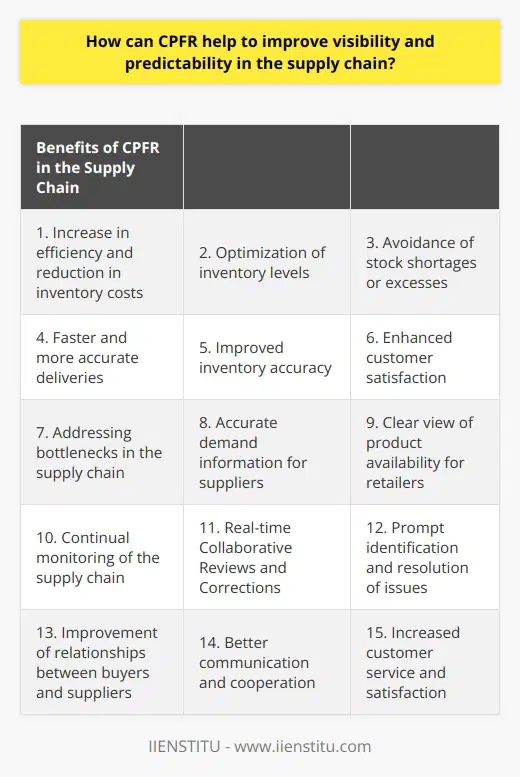
What best practices should be employed in order to unlock the collaborative planning journey with CPFR?
To unlock the collaborative planning journey using CPFR, several core best practices should be employed to ensure the process is effective and efficient. These best practices include using solid strategic partnerships, a thorough understanding of customer demand through demand analysis, creating enterprise-wide views of the supply chain, and the comprehensive oversight of the collaborative planning process from both the supplier and the retailer.
When forming strong strategic partnerships, the retailer and the supplier must be committed to working together to ensure that their collective goals are met. Both parties should communicate their plans, policies, and expectations and be willing to hold each other to them. This means both parties must adhere to agreed-upon processes and procedures to ensure a successful collaborative planning journey.
In addition to forming strong partnerships, a thorough understanding of customer demand is essential for unlocking the CPFR journey. Through demand analysis, companies can better understand customer needs and preferences, allowing them to anticipate upcoming demands better and make the necessary adjustments. This will enable companies to build an effective demand plan that reflects customer needs and a replenishment strategy that ensures an accurate forecast of customer demand.
Using enterprise-wide views of the supply chain is also an essential best practice for unlocking the CPFR journey. Companies can better identify potential issues and develop solutions by comprehensively viewing the entire supply chain. This will promote more efficient operations and ensure successful collaborative planning.
Finally, comprehensive oversight of the collaborative planning process is essential for unlocking the CPFR journey. For the process to succeed, the supplier and the retailer must work closely together to ensure the collaborative planning process is aligned with both parties’ goals and expectations. This means that both parties must regularly review and monitor the process to ensure it runs smoothly and address any potential issues promptly.
In conclusion, several core best practices should be employed to unlock the collaborative planning journey using CPFR. These include using solid strategic partnerships, a thorough understanding of customer demand through demand analysis, creating enterprise-wide views of the supply chain, and the comprehensive oversight of the collaborative planning process from both the supplier and the retailer. Companies can ensure that their collective planning journey is successful by employing these best practices.
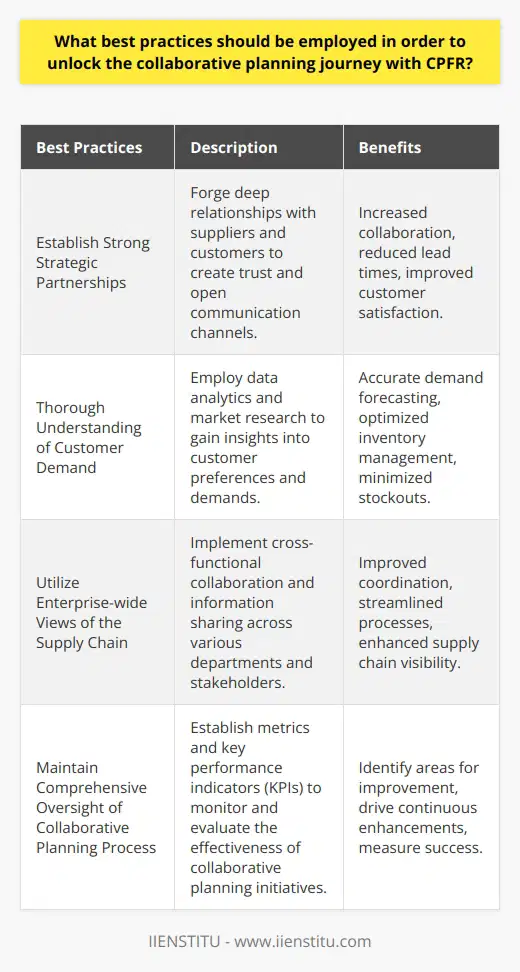
What are the key factors that contribute to the success of implementing CPFR in an organization?
Key Factors in CPFR Implementation Success
Collaborative Planning, Forecasting, and Replenishment (CPFR) has emerged as an essential business process in organizations aiming to improve supply chain efficiency. Various factors contribute to the success of implementing CPFR, including trust and collaboration, information sharing and technology, change management, and performance measurement.
Trust and Collaboration
Establishing trust and collaboration among trading partners is fundamental for the successful implementation of CPFR. This involves fostering open communication, aligning objectives, and committing to shared goals. Partners must also demonstrate flexibility and adaptability to meet the evolving needs and challenges of the supply chain.
Information Sharing and Technology
Effective communication and exchange of data among partners are critical for CPFR success. Adopting standardized data formats and using advanced information technology tools such as Electronic Data Interchange (EDI), Application Programming Interfaces (APIs), and cloud-based solutions can facilitate seamless data sharing. Additionally, organizations must ensure data quality, accuracy, and timeliness to make better-informed decisions.
Change Management
Implementing CPFR requires organizational changes, including revising business processes, modifying organizational structures, and cultivating a culture of collaboration. Organizations must help employees understand the benefits of CPFR and provide training to enable them to adapt to new processes and systems. Effective change management strategies thus play a crucial role in ensuring a smooth transition to CPFR and minimizing disruptions.
Performance Measurement
To evaluate the effectiveness of CPFR implementation, organizations must develop appropriate performance metrics. These metrics should encompass qualitative and quantitative measures, such as cost savings, lead time reductions, inventory optimization, and improvements in customer service. Establishing a system for tracking and evaluating performance will help organizations make data-driven adjustments and improve the overall success of their CPFR initiatives.
In conclusion, the key factors influencing the successful implementation of CPFR in an organization include trust and collaboration, information sharing and technology, change management, and performance measurement. By addressing these factors, organizations can leverage CPFR to optimize supply chain operations and enhance competitiveness in the market.
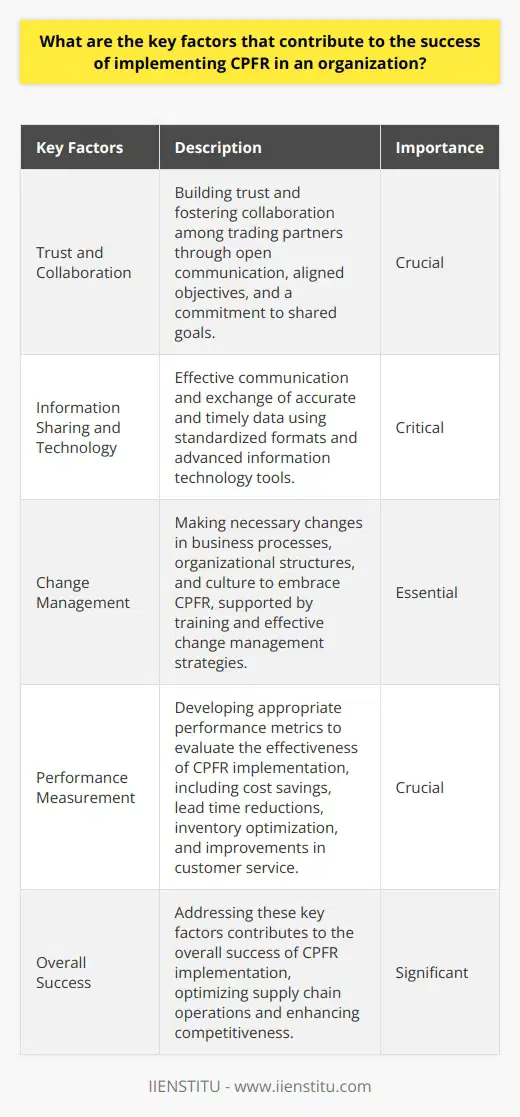
How does CPFR impact inventory management and order fulfillment efficiency?
Impact on Inventory Management
CPFR, or Collaborative Planning, Forecasting and Replenishment, significantly impacts inventory management by fostering collaboration between trading partners, such as suppliers and retailers. The primary goal of CPFR is to enhance supply chain efficiency, aligning processes and reducing costs to both parties involved. This is achieved by integrating data and information flow, enabling better visibility, planning and control over the entire inventory management process.
Improved Forecast Accuracy
One significant benefit of CPFR in inventory management is improving forecast accuracy. Forecasts are crucial for both retailers and suppliers, as they heavily influence production planning and order placement. By communicating and sharing forecasts, trading partners can reach an agreed-upon demand plan, ensuring inventory levels are optimized to meet customer needs, while simultaneously reducing the probability of stockouts and excess inventory. This collaborative approach encourages trust and transparency between both parties, ultimately resulting in more accurate forecasts.
Reduced Inventory Costs
Improving inventory management through CPFR directly impacts order fulfillment efficiency by reducing inventory costs. With better communication and real-time data sharing, trading partners can maintain optimal inventory levels, reducing the need for safety stock and lowering inventory carrying costs. This enables retailers to invest in fast-moving, high-demand products, keeping their inventory levels lean and improving overall order fulfillment efficiency.
Enhanced Order Fulfillment Process
CPFR helps enhance order fulfillment by adopting a proactive approach to replenishment. It shifts the focus from individual efforts to synchronized planning, helping the supply chain respond quickly to fluctuations in demand. This increased agility and responsiveness ensure smooth and efficient order management, leading to better customer experiences and increased sales. Furthermore, the improved coordination between trading partners reduces the risk of order inaccuracies, shipping delays, and other potential supply chain disruptions.
Continuous Improvement and Synchronization
Finally, CPFR encourages continuous improvement and synchronization within inventory management and order fulfillment processes. Trading partners can regularly review and optimize their collaborative methods, enabling them to adapt to changes in the market or shifts in consumer demand. This ongoing learning process improves overall supply chain performance, benefiting both suppliers and retailers.
In conclusion, CPFR positively impacts inventory management and order fulfillment efficiency by fostering collaboration, improving forecast accuracy, reducing inventory costs, and enhancing the overall order fulfillment process. By integrating data and communication between trading partners, CPFR lays a strong foundation for efficient supply chain management, ultimately resulting in better customer experiences and increased profitability.
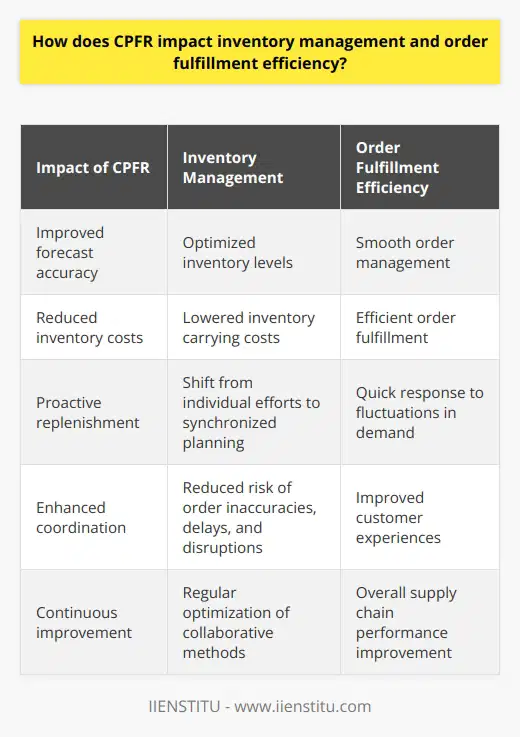
In what ways can CPFR help businesses in reducing risks and uncertainties in supply chain operations?
Enhanced Collaboration in Planning
One way CPFR (collaborative planning, forecasting, and replenishment) helps businesses reduce risks and uncertainties in supply chain operations is by fostering increased collaboration between trading partners. This involves sharing information on demand forecasts, inventory levels, and production plans, which allows both parties to align their supply chain strategies and prevent disruptions.
Improved Forecast Accuracy
Another significant benefit of CPFR is improving forecast accuracy. By using shared data and collaborating on demand planning, businesses can create more accurate forecasts, leading to smoother and more efficient supply chain operations. Better forecasts reduce the risk of stockouts or excess inventory, avoiding potential financial losses and negative impacts on customer satisfaction. Moreover, it allows businesses to allocate resources more effectively and optimize their inventory management processes.
Increased Visibility and Flexibility
Enhanced visibility across the supply chain is another crucial aspect of CPFR. With real-time access to crucial data such as demand changes, inventory levels, and potential bottlenecks, businesses can respond more quickly to unexpected events. This higher flexibility helps mitigate risks, such as supply chain disruptions or unexpected demand surges, and ensures continuity in operations.
Decreased Lead Times and Costs
CPFR also helps reduce lead times and costs, which translates into lower operational risks. By streamlining communication and aligning planning processes, businesses can shorten the time required for replenishment, enabling quicker response to market needs. Additionally, reduced inventory holding costs and improved overall efficiency contribute to healthier financial performance for both parties involved.
Strengthened Supplier Relationships
Lastly, the collaborative nature of CPFR helps businesses establish stronger relationships with suppliers. This long-term cooperation results in improved trust, accountability, and understanding between the partners, providing a solid foundation for risk management. Stronger supplier relationships ensure better communication and facilitate the resolution of potential problems before they escalate, contributing to more resilient supply chain operations.
In conclusion, CPFR significantly contributes to risk reduction and uncertainty management in supply chain operations. By promoting effective collaboration, enhancing forecast accuracy, increasing visibility and flexibility, reducing lead times and costs, and strengthening supplier relationships, this strategy paves the way for more resilient and efficient supply chains. Businesses leveraging CPFR can thus navigate the complex supply chain landscape with greater confidence and competitiveness.
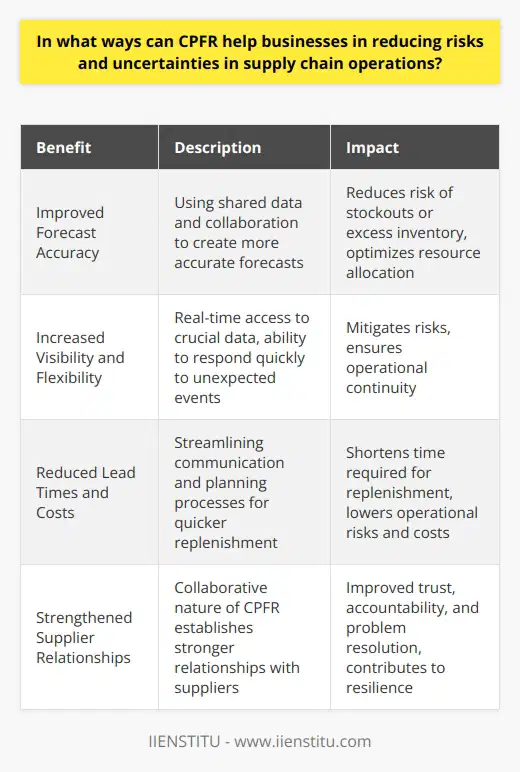
What is a collaborative planning forecasting and replenishment CPFR system and how might it benefit those who choose to implement one?
Introduction to CPFR System
A Collaborative Planning Forecasting and Replenishment (CPFR) system is an advanced approach for managing supply chains, aimed at improving the efficiency and effectiveness of supply chain operations. This system incorporates the use of technology and shared information among various stakeholders in the supply chain to better predict consumer demand and synchronize production schedules, inventory levels, and transportation plans.
Benefits of Implementing CPFR System
Enhanced Forecast Accuracy
One of the main benefits of implementing a CPFR system is the enhanced forecast accuracy it provides. By sharing information and conducting joint forecasts with key suppliers and customers, businesses can more accurately predict and plan for consumer demand, resulting in minimized stockouts and improved inventory management.
Reduced Inventory Costs
Another advantage of utilizing a CPFR system is that it enables businesses to reduce inventory costs. Through increased visibility of supply chain activities and improved demand forecasting, companies can optimize inventory levels, minimizing the costs associated with overstocking and stock obsolescence. This further contributes to increased operational efficiency and cost savings.
Improvement in Customer Service
A CPFR system can also aid in improving customer service levels. By having a comprehensive understanding of demand patterns and supply chain processes, businesses can ensure that products are readily available when needed. This ensures timely delivery of goods to customers and minimizes instances of late shipments or stockouts, resulting in higher customer satisfaction.
Increased Profitability
Ultimately, the implementation of a CPFR system can lead to increased profitability for businesses. Improved forecast accuracy, reduced inventory costs, and enhanced customer service all contribute to lower operating costs and increased sales, driving overall profitability growth. Furthermore, the collaborative nature of the CPFR system encourages stronger relationships between supply chain partners, fostering mutual success and growth.
Conclusion
In summary, a Collaborative Planning Forecasting and Replenishment system is a powerful supply chain management approach that can offer numerous benefits to businesses choosing to implement it. By facilitating information sharing and collaboration among supply chain partners, a CPFR system can result in improved forecast accuracy, reduced inventory costs, enhanced customer service, and ultimately, increased profitability.
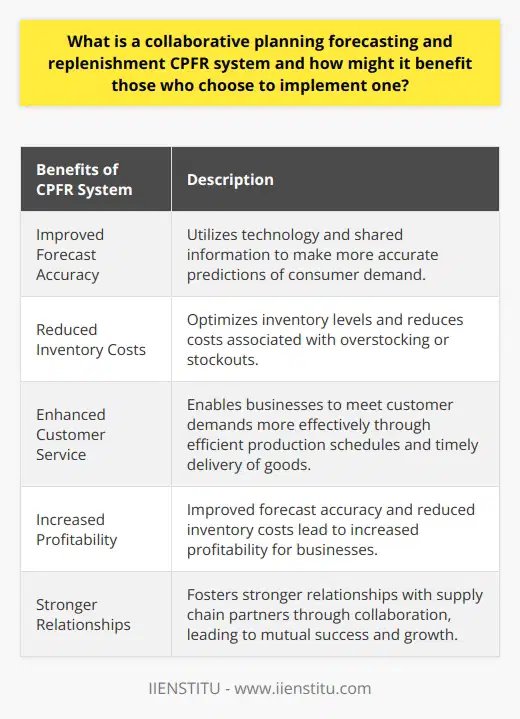
What are the four primary activities in CPFR that facilitate improved supply chain management?
Main Activities in CPFR
Collaborative Planning, Forecasting, and Replenishment (CPFR) is a key strategy to streamline supply chain management. There are four primary activities in CPFR that facilitate improved supply chain management: joint business planning, demand forecasting, production planning, and performance evaluation.
Joint Business Planning
The first activity in CPFR is joint business planning. This involves companies working together to align their goals, strategies, and operations. By doing so, they can accurately forecast customer demand, allowing them to plan their resources accordingly. Joint planning enables partners to collaborate effectively and proactively address potential issues, ensuring a smooth and efficient supply chain.
Demand Forecasting
The second element of CPFR is demand forecasting. It involves the collective analysis of market trends, historical data, and customer demand to predict future needs. This shared forecasting process allows companies to better understand customers' needs and anticipate market fluctuations. As a result, supply chain partners can efficiently allocate resources, manage inventory levels, and optimize production schedules.
Production Planning
A crucial aspect of CPFR is production planning, which revolves around the creation of a shared production schedule. Based on the joint demand forecast, companies can plan when and where products will be manufactured, distributed, and replenished. Shared production plans synchronize the flow of goods through the supply chain, making it more efficient and reducing the likelihood of stockouts, surpluses, or late deliveries.
Performance Evaluation
Lastly, performance evaluation is an essential activity in CPFR. This process involves monitoring and analyzing the effectiveness and efficiency of the supply chain. By regularly reviewing and comparing data such as sales, inventory levels, and lead times, partners can identify areas for improvement, adjust their strategies, and continually optimize their supply chain operations.
In conclusion, the four primary activities in CPFR – joint business planning, demand forecasting, production planning, and performance evaluation – are crucial to facilitating improved supply chain management. By collaborating on these processes, companies can enhance their supply chain operations, ensuring greater efficiency and ultimately leading to higher customer satisfaction.
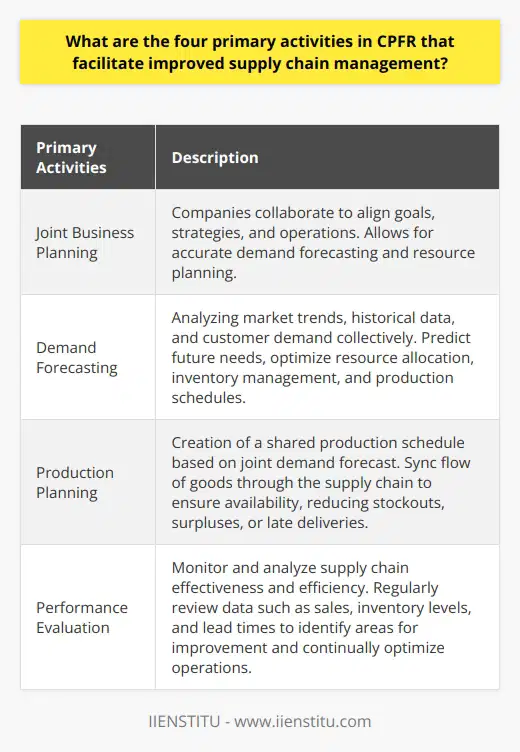
How do the four phases of CPFR in supply chain collaboration contribute to a more efficient and streamlined process?
**Understanding CPFR**
The Collaborative Planning, Forecasting, and Replenishment (CPFR) model is a highly effective supply chain collaboration framework that consists of four key phases: strategy and planning, demand and supply management, execution, and analysis. These phases interact synergistically to enhance the efficiency and streamline the supply chain process.
**Strategy and Planning Phase**
In the strategy and planning phase, supply chain partners jointly develop a strategic plan, outlining mutual goals, objectives, and key performance indicators (KPIs). This collaborative effort aligns the expectations of all stakeholders, resulting in a shared understanding of the desired outcomes and performance targets. Consequently, this strategic alignment fosters improved communication, reduces potential conflicts, and ensures a more seamless integration of the supply chain network.
**Demand and Supply Management Phase**
The demand and supply management phase entails accurate forecasting of consumer demand supported by real-time data and information sharing between partners. By leveraging advanced analytics, partners can jointly predict demand patterns, facilitating optimal inventory planning and minimizing stockouts or excess inventory. This collaborative approach not only reduces inventory holding costs but also ensures product availability, enhancing customer satisfaction.
**Execution Phase**
During the execution phase, supply chain partners synchronize their production, distribution, and selling schedules according to the agreed-upon forecast and inventory plans. Collaborative communication and coordination between stakeholders play a crucial role in this phase, enabling prompt adjustments to any changes in demand or supply conditions. Consequently, this cohesive execution drives the efficiency of the supply chain by reducing lead times and minimizing costs associated with disruptions.
**Analysis Phase**
In the analysis phase, supply chain partners jointly evaluate the performance metrics established in the strategy and planning phase. This systematic review of KPIs promotes continuous improvement as partners can identify areas of inefficiencies, monitor progress towards targets, and iteratively refine their collaborative efforts. The outcome is a dynamic, adaptive supply chain system that continually evolves to drive efficiency and maintain a competitive edge.
**Conclusion**
In conclusion, the four phases of CPFR contribute to a more efficient and streamlined supply chain process by fostering strategic alignment, enhancing demand forecasting, promoting seamless execution, and facilitating ongoing performance analysis. This collaborative approach, underpinned by real-time data exchange and strong communication, enables supply chain partners to minimize costs, reduce lead times, and ultimately deliver superior customer value.
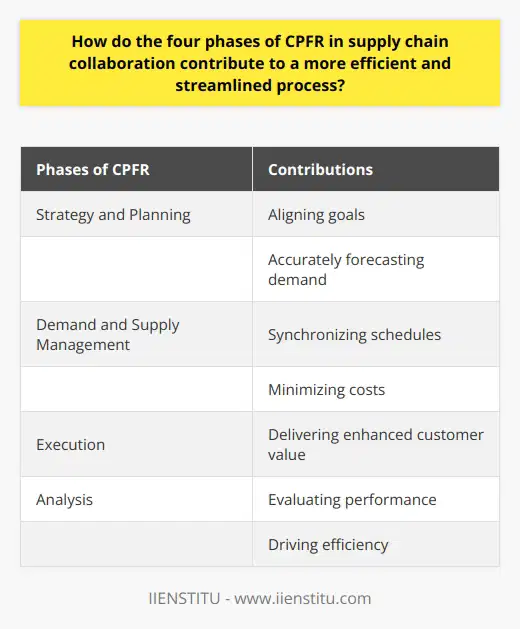
What are the main objectives of collaborative planning, forecasting, and replenishment (CPFR) in supply chain management?
**Objectives of CPFR**
The main objectives of Collaborative Planning, Forecasting, and Replenishment (CPFR) in supply chain management are centered around enhancing overall efficiency and streamlining processes for stakeholders involved in the supply chain. These objectives can be categorized into three primary areas: 1) improving relationships, 2) optimizing resources, and 3) reducing costs and risks.
**Improving Relationships**
One of the principal objectives of CPFR is to foster stronger relationships between suppliers, manufacturers, and retailers by promoting transparency and collaboration on supply and demand planning. This helps to ensure that all parties work in tandem to address mutual business goals and challenges. By sharing information and working together, stakeholders can better understand each other's needs and priorities, leading to improved trust and long-term partnerships.
**Optimizing Resources**
Another crucial objective of CPFR is to optimize the use of resources across the supply chain. This involves aligning forecasts, production, and distribution schedules to meet customer demand while minimizing inventory holding costs. Accurate forecasting and planning can lead to reduced stockouts and overstock situations, which ultimately contribute to enhanced customer satisfaction and increased sales. This optimization process also enables companies to monitor and evaluate the efficiency of their supply chain operations, facilitating continuous improvements over time.
**Reducing Costs and Risks**
Lastly, CPFR seeks to minimize costs and mitigate risks associated with supply chain management. By working together, stakeholders can identify potential areas of vulnerability, such as disruptions in supply, fluctuating market demands, or logistical challenges, and develop contingency plans to address these issues. Furthermore, collaborative planning and forecasting enable businesses to anticipate changes in the market and adjust their strategies accordingly, preventing potential losses due to unforeseen obstacles. The integration of shared information and synchronized processes ultimately leads to decreased operational costs, improved response times, and a more resilient supply chain.
In summary, the main objectives of CPFR in supply chain management are to improve relationships among stakeholders, optimize the use of resources, and reduce costs and risks. These objectives are achieved through processes that encourage collaboration, transparency, and continuous improvement, ultimately resulting in a more efficient and effective supply chain.
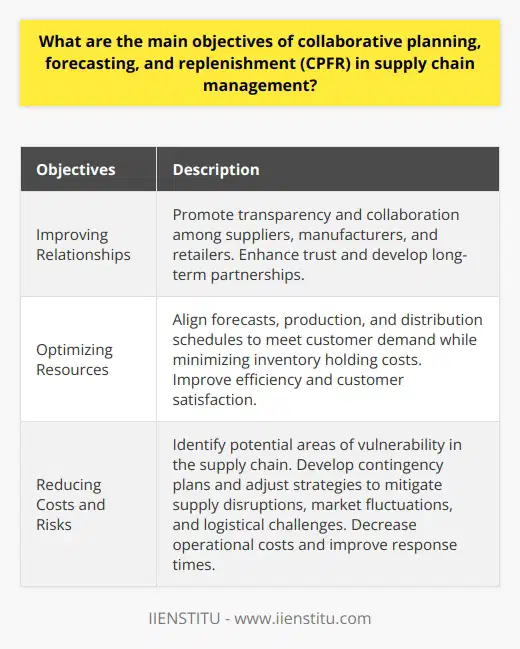
How do the five steps of CPFR contribute to the overall functioning and efficiency of a supply chain?
Contribution of CPFR Steps to Supply Chain Efficiency
Enhancing Collaboration and Planning
The five steps of Collaborative Planning, Forecasting, and Replenishment (CPFR) significantly contribute to supply chain efficiency by enhancing collaboration and effective planning among supply chain partners. The first step, developing a collaboration agreement, forms the foundation for establishing mutual objectives and expectations within the supply chain, promoting transparency and trust among partners.
Improved Forecasting and Information Sharing
Moreover, the second step, joint business planning, streamlines supply chain processes and ensures cohesive decision-making by incorporating the combined knowledge and expertise of all parties. The third step, demand and supply planning, results in improved forecasting accuracy by leveraging advanced data analysis techniques and considering multiple factors influencing demand. This shared understanding of demand patterns helps minimize inefficiencies and reduces lead times.
Managing and Monitoring Performance
The fourth step, execution, focuses on optimally executing the plans and decisions made in previous stages to ensure a seamless flow of goods and services along the supply chain. Timely and accurate order management, replenishment processes, and data sharing are emphasized to further enhance supply chain performance.
Continuous Improvement and Adaptation
Finally, the fifth step, analysis and performance assessment, involves monitoring and evaluating the outcomes of the implemented strategies for continuous improvement. This step enables supply chain partners to identify areas requiring corrective actions, leading to continuous adaptation and improvement of the supply chain processes. In conclusion, the effective implementation of the five CPFR steps fosters a dynamic and well-coordinated supply chain, enhancing overall efficiency and reducing operational costs.
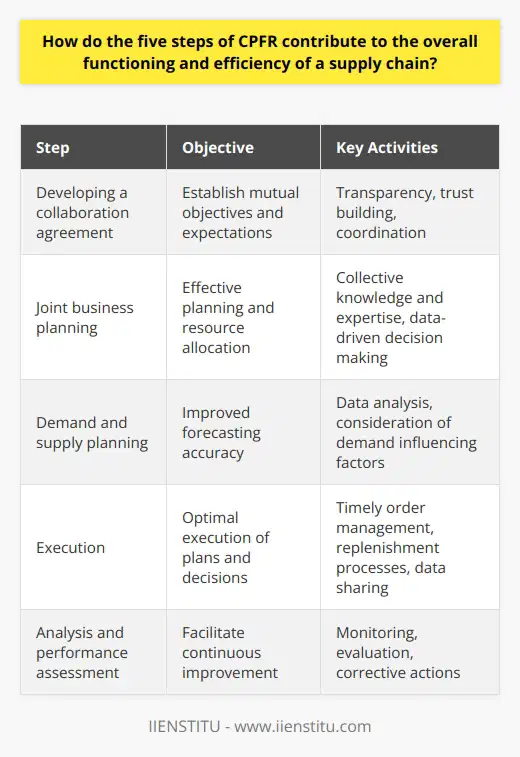
In what ways can the four phases of CPFR in supply chain collaboration lead to better performance and profitability?
Understanding the Four Phases of CPFR
The Collaborative Planning, Forecasting, and Replenishment (CPFR) model in supply chain collaboration can significantly contribute to better performance and profitability. By examining the four phases of CPFR, this paragraph seeks to identify the benefits each stage offers to an organization.
Strategy and Planning Phase
During the strategy and planning phase, supply chain partners develop a joint business plan that outlines their shared goals and objectives. This collaboration establishes a solid foundation for the relationship, streamlines the decision-making process, and optimizes resource allocation. As a result, partners witness improvements in forecast accuracy and experience reduced inventory costs.
Demand and Supply Management Phase
The demand and supply management phase involves creating accurate sales forecasts and adjusting the supply chain operations accordingly. By sharing information and expertise, organizations can better predict fluctuations in customer demand and develop flexible production plans. This responsiveness ensures that companies minimize stockouts and overstocks, leading to increased customer satisfaction and reduced inventory holding costs.
Execution Phase
During the execution phase, supply chain partners implement the agreed-upon plans collaboratively. This alignment ensures an efficient flow of goods and information between the parties, reducing lead times and minimizing the risk of stock shortages or excess. Consequently, businesses enjoy cost savings, improved cash flow, and increased sales.
Analysis and Performance Monitoring Phase
The analysis and performance monitoring phase involves assessing the outcomes of the implemented strategies and plans. By regularly examining key performance indicators, organizations can determine any weaknesses or areas for improvement within their supply chain. This continuous evaluation fosters a culture of learning and adaptation, enabling companies to remain competitive and drive long-term growth.
Conclusion
In summary, the four phases of the CPFR model foster efficient supply chain collaboration, resulting in better performance and profitability for organizations. By aligning strategies, optimizing demand and supply management, executing plans seamlessly, and continuously monitoring performance, supply chain partners cultivate strong relationships and drive sustainable growth together.
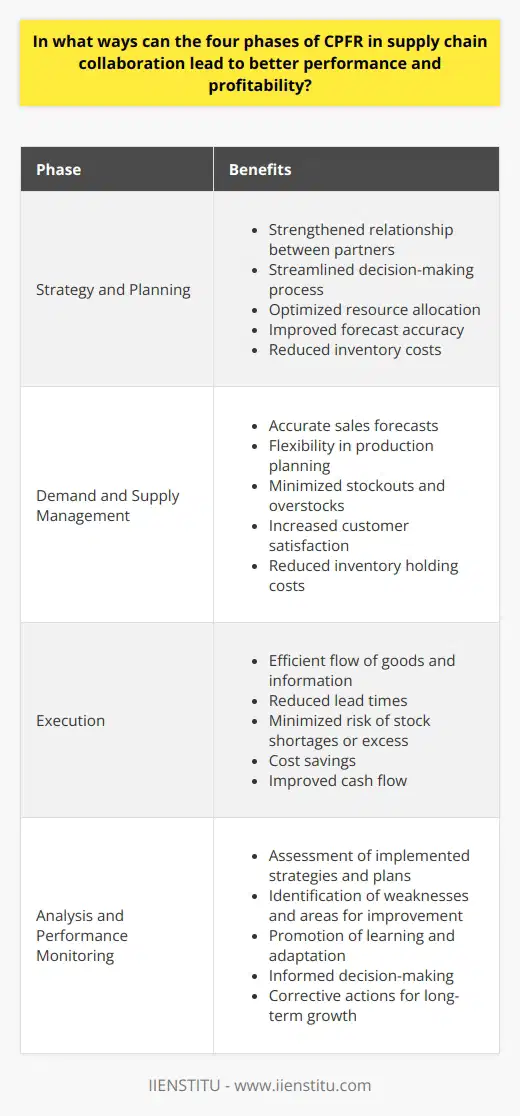
What are the benefits of CPFR program?
Benefits of CPFR Program
Improved Forecast Accuracy
One of the primary benefits of the Collaborative Planning, Forecasting, and Replenishment (CPFR) program is improved forecast accuracy. By collaborating and sharing data between retailers and suppliers, both parties can create a more accurate demand forecast based on real-time information. This improves the overall efficiency of the supply chain by reducing instances of over- or under-stocking, and minimizing stockouts.
Cost Reduction
The CPFR program helps to reduce costs in several ways. Through better forecasting, retailers can avoid the costs associated with stockouts, such as lost sales and customer dissatisfaction. Suppliers can reduce their inventory holding costs by aligning their production schedules with the retailer's demand forecasts, thereby minimizing the risk of having excess stock. Furthermore, improved communication between retailers and suppliers can lead to a reduction in administrative costs, as order processing times are streamlined, and errors are minimized.
Enhanced Collaboration
CPFR promotes a collaborative approach between retailers and suppliers. This encourages trust, transparency, and communication between the two parties, fostering a stronger working relationship. This improved relationship can, in turn, contribute to better problem-solving and decision-making, as retailers and suppliers can work together to address challenges and opportunities within the supply chain.
Increased Customer Satisfaction
By implementing CPFR, retailers can ensure that they have the right products in the right quantities at the right time. This enhanced product availability is crucial in ensuring customer satisfaction. A satisfied customer is more likely to remain loyal to the retailer, leading to increased long-term profitability.
Environmental Benefits
Finally, the CPFR program can lead to environmental benefits, as improved forecasting can result in less waste due to product obsolescence and perishability. In addition, more efficient production and distribution processes can lead to reduced carbon emissions, as a result of fewer excess shipments and expedited transportation.
In conclusion, the CPFR program offers numerous benefits to both retailers and suppliers, including improved forecast accuracy, cost reduction, enhanced collaboration, increased customer satisfaction, and environmental benefits. By implementing this collaborative program, businesses can optimize their supply chain processes, strengthen their working relationships, and ultimately improve their overall performance.
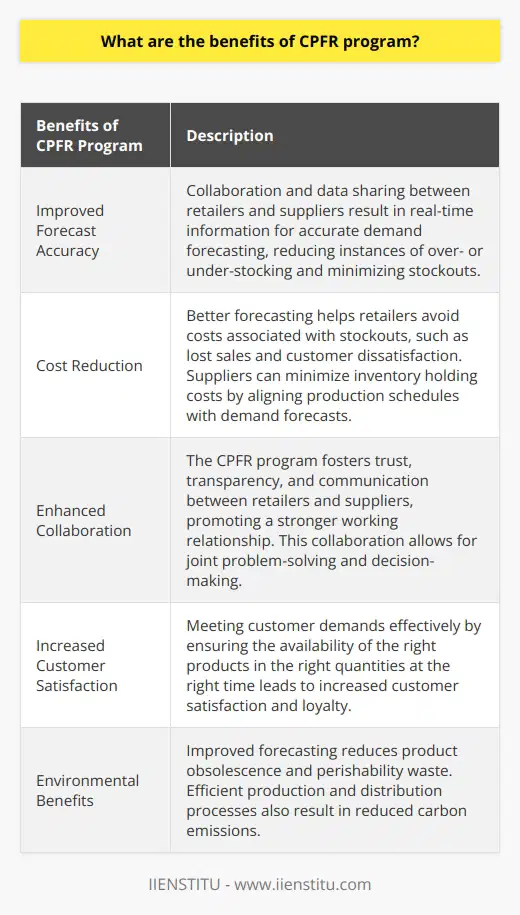
What is CPFR list four 4 benefits that can be achieved by implementing a successful CPFR program?
Collaborative Planning, Forecasting, and Replenishment (CPFR)
CPFR is a supply chain management strategy that integrates various members within the chain to collaboratively plan, make demand forecasts, and manage product inventory. The implementation of a successful CPFR program can yield various benefits for businesses and organizations involved in the supply chain, including the following four advantages:
Cost Reduction
One significant benefit of implementing a CPFR program is the reduction of costs throughout the supply chain. By improving communication and collaboration between suppliers, manufacturers, and retailers, redundancies and inefficiencies within the inventory management process are minimized. This leads to less waste, lower carrying costs, and reduced overall expenses.
Improved Forecast Accuracy
Another benefit of CPFR is the ability to improve the accuracy of demand forecasts. By sharing and analyzing data from multiple sources across the supply chain, organizations can develop more precise sales projections. This enhanced forecasting ability enables businesses to plan and allocate resources more effectively, better anticipating customer needs, and preventing stockouts or excess inventory situations.
Shortened Lead Times
The implementation of a CPFR program can lead to shortened lead times in the supply chain. By creating a collaborative environment and promoting the sharing of information, businesses can streamline their operations and respond more quickly to customer demands. This reduction in lead times can result in quicker order fulfillment, enhancing customer satisfaction and increasing the likelihood of repeat business.
Strengthened Relationships
Lastly, CPFR promotes the development of stronger relationships among supply chain partners. By working together and fostering a more open and transparent communication flow, trust and understanding between organizations can improve. In turn, this enhanced collaboration can lead to a more stable and responsive supply chain that is better equipped to handle unexpected challenges and market disruptions.
In conclusion, implementing a successful CPFR program can offer numerous benefits for businesses and organizations involved in the supply chain. By reducing costs, improving forecast accuracy, and promoting better communication and cooperation, CPFR can help organizations to optimize their operations and gain a competitive advantage in the marketplace.
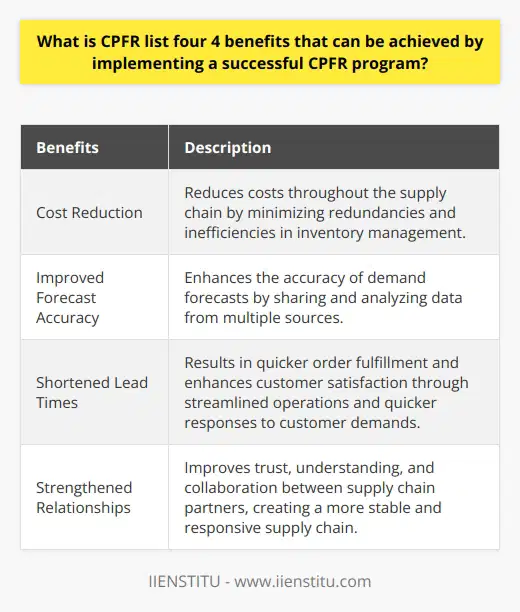
What are the 4 phases of CPFR in supply chain collaboration?
Phases of CPFR in Supply Chain Collaboration
Overview of CPFR
The concept of Collaborative Planning, Forecasting, and Replenishment (CPFR) is an essential strategy in supply chain management, aiming to enhance cooperation and coordination among trading partners. The process involves sharing information, aligning goals and objectives, and synchronizing supply with demand. The CPFR model comprises four primary phases: strategy and planning, demand and supply management, execution, and analysis.
Strategy and Planning Phase
The first phase of CPFR initiates collaboration between trading partners. It focuses on establishing mutual trust, defining joint goals, and developing cooperative practices. Both parties must identify their roles, responsibilities, and the resources they will provide. They must also agree on the critical performance indicators (KPIs) and targets to measure success and progress.
Demand and Supply Management Phase
The second phase revolves around generating and maintaining accurate demand forecasts and supply plans. Trading partners must collaborate on demand forecasting, taking into account variables such as seasonal trends, promotions, and inventory levels. Similarly, the supply planning aspect entails managing supplier capacity, lead times, stockouts, and replenishment requirements. Ultimately, this phase aims to achieve the right balance between demand and supply.
Execution Phase
At the execution phase, the partners must ensure smooth implementation of the agreed-upon plans. They must coordinate and monitor sales, inventory levels, and delivery schedules, ensuring transparency and real-time communication. Additionally, partners must also address emerging discrepancies and make necessary adjustments based on changes in demand patterns. In this stage, fostering cooperation among all stakeholders is crucial to achieving optimal efficiency.
Analysis and Continuous Improvement
Lastly, the fourth phase of CPFR involves evaluating the results and drawing insights to drive continuous improvement. Trading partners must analyze the KPIs and assess the performance of their collaborative initiatives. This involves identifying bottlenecks, best practices, and opportunities for improvement. By leveraging the learning and insights gathered, partners can fine-tune their strategies and plans, resulting in more efficient supply chain management.
Conclusion
CPFR offers a systematic approach to supply chain collaboration, enabling businesses to optimize their operations, reduce costs, and maximize customer satisfaction. By adopting the four-phased approach—strategy and planning, demand and supply management, execution, and analysis—trading partners can achieve greater alignment, agility, and responsiveness in their supply chains.
